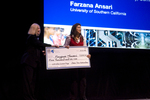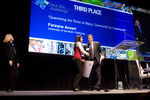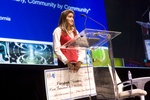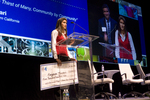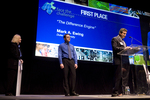- 2013 Research Triangle Park Summit
- 2013 Global Summit - London
- 2010 National Summit - Los Angeles
- 2010 Seattle Summit
- 2010 Chicago Summit
- 2010 Boston Summit
- 2010 Phoenix Summit
- 2010 Raleigh Summit
- 2009 National Summit - Durham
- Plenary Talk - Charles Vest
- Session I: Energy and the Environment
- Session II: Health
- Session III: Entrepreneurship
- Session IV: Security
- Session V: National Survey Findings
- Session VI: Understanding the Brain: Learning and Computation
- Session VII: Big Idea Panel
- Video/Essay Winners
- Speaker & Panelist Bios
- Poster Contest Winners
- Organizing Committee
- Summit Sponsors
- National Survey Results
- Grand Challenge Scholars Program
- Grand Challenge K12 Partners Program
Video/Essay Winners
As part of an educational outreach effort in conjunction with the Summit event, Duke University sponsored a national video/essay contest. We asked college students in the United States to create videos between two and three minutes in length AND a 1,000 word essay with bibliography in response to the question: Which of the 14 grand challenges identified by the National Academy of Engineering would YOU choose to address, and how would you do it? Read details about the judging criteria.
We received 28 outstanding entries from 14 different universities across the nation. The top three winners were shown Monday, March 2 at the Summit on the National Academy of Engineering Grand Challenges event in Durham, NC.
Thank you to our judges:
- Jason Piche, Intellectual Property Attorney, IBM Corporation
- Janis J. Rehlaender, Retired, Director of Corporate Planning, Baxter International; Chairman, Darien, CT Board of Education
- Martha M. McDade, President, Environmental Excellence Engineering P.C.
- Rebecca Lula, Founder and President, K1 Concepts
First Prize - $15,000 Winner
Mark Andy Ewing, Duke University
Video link: http://www.youtube.com/watch?v=A91wnIQL5Ts
Submission Title: The Difference Engine
Essay:
This idea matured over the last 6 months of observing the political and economic changes in the United States. It finally gelled when a colleague of mine who had been very critical of the Department of Homeland Security (DHS) in the past told me that she had changed her opinion of them. When I asked what it was that influenced this change of mind, she told me that she had seen the DHS reality television show, and it humanized the employees of the DHS to such a degree that she couldn't think of them as "stupid" or "evil" anymore.
I realized that part of the power to do good in the world is simply the power to build consensus, and it is not enough to have consensus on just what SHOULD be done, but the consensus must include the HOW as well. I believe that this nonprofit, the Difference Engine, could be the most important solution to the "Engineer the Tools of Scientific Discovery" Challenge, because discovery needs funding, and success often begets success. I also believe that it is a viable organization in a budgetary and operational sense.
Bill Gates, Bono, and others have shown that those with money and influence have a great desire to do good in the world, but not only to do good, but to make sure their donations have the biggest impact possible. By focusing our organization on a few technologies that have already passed the bar of proof-of-concept, prototype and commercial/political viability, we are ensuring that our efforts to "get the word out" will be fruitful.
In terms of actually getting the word out, more and more media, such as the television shows "House" and "CSI" and the websites Slashdot and Lifehacker derive their value from being at the forefront of technology, and by picking the next "big" thing before everyone else does. In that sense, we won't be so much soliciting their charity in showcasing these technologies, we'll be providing them with a service that goes directly to their value as products.
Measuring "success" is a matter of tracking product sales and/or political polls, and since the marketing team will be targeting specific demographics, perhaps in specific areas, there's room to measure an increase in awareness or interest in reference to "control" groups.
There are two other teams in the engine not mentioned in the video. First, a small but strong administrative team is necessary to actually track success and chart our course. Second, a fundraising team will be generating financial support at all levels of private donation. It is important that the nonprofit not be a publicly funded entity, in order to maintain its credibility. In the same vein, after, the initial start-up period, funding should come from a variety of private sources, with no one source contributing more than, say, half of the total.
So many challenges that we face, from clean water to global warming to improved health care are immediate in their nature. Every day that a new solution is delayed in reaching those who need it is a day we cannot afford. I believe this organization, the Difference Engine, is a necessary part of our work in improving the human condition around the world.
About Mark: Mark is a 2nd year doctoral student at Duke University in the Department of Electrical and Computer Engineering. Originally from Atlanta, GA, Mark prompted to enter the video/essay contest in part by conversations over the past year with his wife about making our respective fields "relevant". "In my case, it seems easy, that Electrical Engineering is driving most of the technology that we use, but even technology can take a while to reach daily use, and it's a shame that we lose so much time when good solutions are available," Mark writes. Long term, Mark hopes to be be self-employed, either with the Difference Engine or another project. In the short-term, he is looking for an industry position in the area.
Second Prize - $10,000 Winner
Brian Chan, Massachusetts Institute of Technology
Team member: Joyce Kwan
Video link: http://www.youtube.com/watch?v=iADqQLe2u0U
Submission title: Carbon sequestration and biofuel production by thermal depolymerization
Essay:
Introduction. 300 million years ago, during the Carboniferous era, lush prehistoric forests covered the earth, thriving on carbon dioxide [3]. For hundreds of millions of years, the forests helped contribute to the fixation of carbon, bringing CO2 to the stable levels we have today. When the forests died, they were buried under layers of rock, where massive amounts of pressure and heat transformed their remains into deposits of coal and oil. These reserves of coal and oil have fueled most of our technological advances in the modern age. We owe much of our quality of life to this massive supply of energy. Unfortunately, we are consuming these energy reserves at a rate many thousands of times faster than the rate at which they were formed, and in the foreseeable future, we will run out of fossil fuel reserves. What’s more, the day which we run out of this fuel source approaches faster and faster with the increasing rate of modernization. Meanwhile, the resultant increase of carbon dioxide and other pollutants in the atmosphere and in the oceans can drastically affect life on this planet, leading to climate change and mass extinctions [1]. Many forms of life, including humans, might not be able to adapt to these new changes.
Thermal Depolymerization. If we wish to sustain our technological advancement and preserve the ecosys-
tem, we will need to find a renewable source of energy that contributes no net carbon dioxide to the environment. Furthermore, we need to find a way to sequester the current surplus of carbon dioxide in the atmosphere. One promising method, thermal depolymerization, is directly inspired by the natural processes that provide us with fossil fuels. In this process, organic matter is decomposed into carbon and oil by the application of steam, heat, and pressure. Several companies are already processing waste products into fuels this way [5, 2]. They found that a variety of materials could be used: turkey waste, plastics, sewage and tires can all be transformed into a usable oil similar to crude oils, but with far fewer contaminants, such as the sulfur
found in fossil fuels [4]. The solid carbon derived from the initial treatment of this biomass could be sequestered or it could be reused to fuel power plants.
Another option would be to create liquid fuels from the carbon using proven methods such as Fischer-Tropsch synthesis [6]. When the carbon is derived from renewable sources, the total amount of carbon in the ecosystem remains the same regardless of the way it is utilized. In addition to being clean and renewable, the manufacture of fuels by thermal depolymerization has several advantages over other alternative fuels:
- The process outputs solid carbon as well as oil, and is therefore both a method of carbon sequestration and of fuel generation.
- The process is flexible, so the same reactor can be used to process a variety of raw materials, depending on supply.
- The steps involved are much simpler than biochemical processes, such as fermentation.
- Unlike biodiesel, which is extracted from plant oils, thermally depolymerized fuels can be derived from the entirety of the input material.
The higher conversion rate would translate to higher efficiency of production and less required land to produce a given amount of fuel.
The Plan. The processing of waste products into fuel represents an important milestone in the search for alternatives to fossil fuel, but it is only the first step - we need to explore the full potential of thermal depolymerization. It promises to close the carbon cycle and to provide a stable, long-term supply of energy
which is compatible with the existing framework. However, because the field is relatively new, widespread integration of a new fuel into the current infrastructure is an ambitious undertaking. To make this technology feasible, we need to take several important steps:
- We will need to look into other forms of biomatter, besides waste materials, that can be efficiently made into fuels. Research needs to be done to find the most economical feedstocks for fuel synthesis, and the optimal processing strategy.
- Once the science is sufficiently understood, the next step would be to construct dedicated sites to grow feedstock and process it into oil.
- It will be necessary to emphasize the importance of reducing carbon emissions. One way to do this would be to enact a carbon tax. Another way to encourage the carbon-neutral technologies, once they are viable, would be to subsidize the research and production of the new fuels until they have developed enough to grow independently.
Conclusion. The adoption of these fuels would recycle the carbon dioxide emitted by their use, and sequester carbon during their manufacture. By combining this technology with other emerging types of energy generation, such as wind and solar power, we will have the ability to power human advancement without making a negative impact on the environment. The rate of modernization of all countries in the world will only increase as well as the rate of energy consumption. The choices we make concerning energy in developing countries will set an important example for the rest of the world for future generations.
References
[1] “Greenhouse Gases, Climate Change and Energy”. Technical report, National Energy Information Center, Washington, DC 20585, 2008.
[2] J. DeFore. “E-Fuel: A Coal Substitute Made from Sewage”. http://www.greenrightnow.com/kvue/2008/07/08/e-fuel-a-coal-substitute-made-from-sewage/, 2008.
[3] C. Duve. Vital Dust: The Origin and Evolution of Life on Earth. Basic-Books, New York, 1995.
[4] B. Lemley. “Anything Into Oil”. http://discovermagazine.com/2003/may/featoil, 2003.
[5] B. Lemley. “Anything Into Oil”. http://discovermagazine.com/2006/apr/anything-oil, 2006.
[6] R.F. Probstein and R.E. Hicks. Synthetic Fuels. Dover Publications, New York, 2006.
Third Prize - $5,000 Winner
Farzana Ansari, University of Southern California
Video link: http://www.youtube.com/watch?v=WwQeb8WSyu4
Submission title: Quenching the Thirst of Many, Community by Community
Essay:
My memories of visiting Mumbai, India with my parents are still quite vivid. I can recall the abject poverty lining even the most upscale districts of the city, slums climbing the urban walls and commercial buildings like vines. Wooden shacks with no doors and precariously placed roofs housed refrigerators, lighting fixtures, and even the occasional television. But perhaps the most memorable images of these poverty-stricken avenues were the three-foot high pipes that ran behind the shacks, carrying mucky, yellowed liquid that served as a drinking source for the millions living on the streets.
Mumbai stands as my living reminder at how desperate the global need for access to clean water really is. This metropolis is only one home of many to the 2.5 billion people who are left without sanitary drinking water on a daily basis [1]. It is reported that over 5 million people die each year from water-born diseases, 98 percent of which live in developing nations [2]. In these countries, poor sanitation facilities – if any exist – are unable to prevent bacterial contamination mostly attributed to human defecation near or in local water resources. Furthermore, 26 countries have been deemed “water scarce” in which failed irrigation facilities, drought, or exhaustion of traditional resources have left an estimated 436 million without any water supply – a number the World Bank believes will rise to 1.4 billion people in 48 countries by 2025 [3].
Attempting to reduce these dramatic numbers requires us to bring down our focus from the millions to the hundreds. Simply implementing large-scale filtration technologies throughout the world does not completely address the fundamental challenges of sustainability and affordability in developing countries, as demonstrated by the irrigation pipes carrying unsanitary water through Mumbai’s slums. Instead, a multidisciplinary approach integrating engineering solutions with cultural understanding and education must be adopted to address each community’s specific needs and limitations. Solutions should involve the resources and people of a given community in need, whether to operate portable filters in a family household or to construct simple mechanical pump systems for small neighborhoods.
Employing community members and their resources to implement engineering solutions has several benefits, the first of which is more targeted educational measures. A focus on smaller communities enables a better understanding of not only the technological needs and restrictions of the environment and people, but also the knowledge gap that exists in regard to sanitation and hygiene. The Haath Mein Sehat (HMS) project in Mumbai involves a comprehensive program that distributes affordable and portable filtration systems as well as hosts several public workshops, street plays, and market stalls to educate community residents on basic hygiene [4]. UC Berkeley students and local Mumbai college students conduct needs assessments to obtain a better understanding of existing treatment methods and water sources, and subsequently provide educational resources for residents to make better decisions about their drinking water.
The ability to provide a more holistic education on sanitation closely ties to a second benefit of the small-scale filtration or water pump approach: sustainability. HMS workshops and public performances are able to target fundamental hygienic tasks, such as washing hands or using toilets, thus preventing later recontamination of clean water resources. The USC collegiate chapter of Engineers Without Borders (USC EWB) approached the ideas of sustainability through the design of a centralized water pump in rural Honduras. Students in the organization searched out and purchased supplies from the native country, including PVS pipe, steel pipe, concrete, rebar, bricks, and industrial materials needed for a pump and filter [5]. In addition, community members gathered natural resources such as gravel and sand as well as volunteered their labor and learned how to build and maintain the system themselves.
In addition to involving residents with the construction of pump and/or filtration systems, some projects have tried to achieve sustainability through active participation of the community after the system is installed. PlayPump International, a non-profit organization, decided to focus on serving the youth of rural areas through installation of a 1,000 merry-go-round water pumps throughout sub-Saharan Africa. Like USC EWB, the South African organization recruits locals to install the pump, which consists of a roundabout that drives water from an underground source into a 2,500-liter tank that stands about seven meters above ground [6]. In addition to providing play equipment for local children, the four-sided tank has two billboards for local consumer advertisements and two more for educational health messages. Any profit generated is then used by the community to maintain their system.
PlayPump International’s revenue production through advertisement is also exemplary of how smaller, more integrative clean water projects can open up new avenues for funding. Many ongoing projects are seeking ways to incorporate local materials and labor into their systems, and in doing so are promoting investment in developing nations and avoiding costs incurred by importing more expensive (and more complicated) technologies. Furthermore, some philanthropists have discovered more appeal in the successes of collegiate and nonprofit focused efforts in smaller communities and chosen to donate to their cause. In April of 2008, the Davis Projects for Peace program sponsored 79 socially innovative projects that included a proposal by Middlebury freshman Shabana Natisa Basij-Rasikh that seeks to install six wells in the outskirts of Kabul that will serve clean drinking water to over 6,000 residents [7].
Through non-profit efforts across the world, student and private organizations alike have demonstrated how direct engagement with communities in need ultimately results in more effective and visible results in both the short and long term. Engineers, entrepreneurs, and social activists need to work together and unite cultural awareness with engineering creativity to establish a lasting and hygienic water supply for future generations. Like any engineering challenge, the lack of access to clean water requires engineers to witness the problem firsthand before they can design a solution. Direct engagement with the hundreds who suffer throughout the globe will enable us to eventually save the millions looking to quench their thirst.
About Farzana: Farzana Ansari is a senior in engineering at the University of Southern California. Originally from Riverside, California, she is majoring in biomedical engineering and plans to pursue a master degree in mechanical engineering. Farzana was prompted to enter the video/essay contest because she was inspired by the NAE’s initiative to unite engineers across the nation – and across the world – to identify the priorities in technology today and brainstorm solutions to the challenges we face. Furthermore, the goals of the Grand Challenges tied in closely with my beliefs as an editor of USC’s online engineering magazine Illumin: to explore the impact engineering has on everyday life. She wrote, “I believed that entering this contest would further my motivation to continue understanding the social and political influences that engineering has on the world.” Farzana plans to enter the medical device industry, hopefully to work on cardiovascular or rehabilitative devices. And of course in between, she wants to take every opportunity I can to travel the world. Through her research, Farzana writes that she was incredibly impressed by how there is never one solution to an engineering challenge; rather, there are many solutions that seek the same goals. The key is direct engagement with the community we serve, whether it’s the nurses in hospitals who deal with health informatics on a daily basis or the impoverished who needs access to clean water in the slums of Mumbai.
Bibliography
[1] World Health Organization and United Nations Children’s Fund Joint Monitoring Programme for Water Supply and Sanitation (JMP). Progress on Drinking Water and Sanitation: Special Focus on Sanitation. UNICEF, New York and WHO, Geneva, 2008.
[2] Peter H. Gleick. Dirty Water: Estimated Deaths from Water-Related Disease 2000 – 2020. Pacific Institute for Studies in Development, Environment, and Security, August 15, 2002.
[3] Parliamentary Office of Science and Technology. “Access to Water in Developing Countries.” Postnote, Number 178, May 2002.
[4] Anu Sridharan. Engineers for a Sustainable World (UC Berkeley). Telephone Interview. January 15, 2009.
[5] Alex John. Engineers Without Borders (University of Southern California).Personal Interview. January 14, 2009
[6] Play Pump International. “How the PlayPump Works.” Last updated December 2008. http://www.playpumps.org; Accessed January 16, 2009.
[7] Blair Kloman. “Two Middlebury College student proposals receive funding from Davis Projects for Peace.” Published April 23, 2008. http://www.middlebury.edu/about/pubaff/news_releases/2008/pubaff_633445491175819496.htm, Accessed January 16, 2009.
Summit TopicsSummit SpeakersSpeaker InterviewsSpeaker Topics



